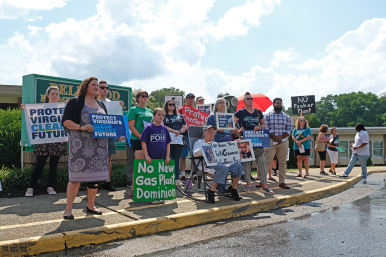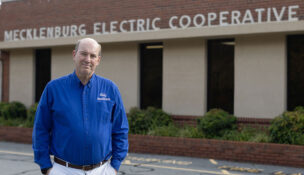Natural selection
Does natural gas have a place in Virginia’s carbon-free future?

As pictured in this rendering, Dominion Energy announced plans in 2023 to begin building a natural gas peaker plant in Chesterfield County in 2025, with completion set for 2027. Rendering courtesy Dominion Energy

As pictured in this rendering, Dominion Energy announced plans in 2023 to begin building a natural gas peaker plant in Chesterfield County in 2025, with completion set for 2027. Rendering courtesy Dominion Energy
Natural selection
Does natural gas have a place in Virginia’s carbon-free future?
Natural gas as a source of energy for Virginia power plants is set to reach its final days by the middle of the century — or is it?
The Virginia General Assembly set that deadline in 2020 when it passed the Virginia Clean Economy Act, which requires the state’s two major electric utilities to shift to carbon-free, renewable energy sources such as wind and solar power for electricity generation, seemingly leaving no place for fossil fuels such as natural gas or coal.
Republican Gov. Glenn Youngkin has advocated for revisions to the act to include other power sources such as natural gas, a nonstarter for the Democratic-majority General Assembly. But Dominion Energy‘s proposal to put a natural gas plant in Chesterfield County has raised questions about whether the company, which serves 64.4% of Virginia, will meet the state mandate to produce all power for Virginia customers from renewable energy sources by 2045.
West Virginia-based Appalachian Power must meet the same carbon-free target by 2050, but “we’re a small player in Virginia,” says Teresa Hamilton Hall, senior corporate communications consultant. The company, which serves about 20% of the commonwealth, has only one natural gas plant in Virginia. “The majority of our electricity generation,” Hall says, “is still from coal.”
Over the past two decades, Dominion has reduced its greenhouse gas emissions substantially, according to the company. Through 2022, Dominion says, it “reduced carbon emissions from power generation by 47% (compared with a 2005 baseline), and methane emissions from gas operations are down 38% (from a 2010 baseline).”
“We’re all-in on renewables,” says spokesperson Aaron F. Ruby. “About 95% of our new power plants are carbon-free. We’re currently building an offshore wind project off Virginia Beach. There’s a call for a second. We’re expanding our battery storage fleet, [and] that allows us to store from wind and solar during periods of low demand.”

Dominion has divested much of its natural gas transmission and storage assets in recent years, following the cancellation of its proposed Atlantic Coast Pipeline project with Duke Energy in 2020. The aborted 600-mile natural gas pipeline, which faced long delays amid legal challenges, was supposed to run from West Virginia to eastern North Carolina through Virginia.
In 2020, Dominion sold the majority of its gas transmission and storage assets to Berkshire Hathaway Energy for $8 billion. The Richmond-based Fortune 500 utility sold its remaining interest in the Cove Point natural gas liquefaction facility in Maryland to Berkshire Hathaway for $3.5 billion in July 2023. Two months later, Dominion announced it was selling its three natural gas distribution companies to Canadian pipeline and energy company Enbridge for $14 billion. The $6.6 billion sale of East Ohio Gas closed in March, with the other sales expected later this year.
All of this comes at the same time as the Biden administration has paused approvals on new liquefied natural gas export facilities while the Energy Department examines the environmental, economic and political impacts. The United States was the world’s largest LNG exporter last year, and the Cove Point facility Dominion sold exported LNG to nearly 30 nations.
That’s not to say that Dominion is completely done with natural gas, however. The company has about a dozen natural gas plants in Virginia that generate about 35% of its electricity in the state.
And the demand for that power is only expected to grow. It’s been projected that the demand for energy from Virginia’s fast-growing data centers industry could quadruple by 2038, accounting for about 50% of Virginia’s total electricity supply.
Plans for Chesterfield
Last summer, Dominion revived plans first proposed in 2019 to build a natural gas peaker plant — a plant that would run only during periods of high demand or during extreme weather — in Chesterfield County. (Chesterfield was previously home to two Dominion coal plants that were deactivated in 2023 after more than 50 years.)
Consisting of four natural gas-powered turbines, the company says the proposed Chesterfield Energy Reliability Center would serve as “an ‘always ready’ generation resource that can be quickly deployed on the hottest and coldest days and serve as backup generation when other resources are unavailable or insufficient to meet customer needs.”
Construction on the plant is planned to begin in 2025 and be completed in 2027, according to Dominion. The cost hasn’t been released, but the project was estimated at $600 million in 2019. Dominion has applied for state and local permits for the facility, which requires approval from the State Corporation Commission, a process expected to take about nine months.
Once fully operational, the project would generate approximately 1,000 megawatts — enough energy to power up to 250,000 homes.
In late February, Chesterfield residents and regional activists opposed to the project gathered for a town hall led by state Sen. Ghazala Hashmi, D-Chesterfield County. It included members of Friends of Chesterfield, a community group that opposes the project on multiple grounds, including health concerns for area residents, about 44% of whom are people of color, according to the Environmental Protection Agency.
In mid-March, a coalition of nine Democratic state legislators from Central Virginia, including Hashmi, issued a statement in opposition to the plant. “Dominion Energy’s current pursuit of permits to build a new gas-fired power plant in Chesterfield County undermines the state’s transition to clean and renewable energy,” the legislators wrote. They also pointed out that, according to a May 2023 SCC filing from the utility, Dominion expects that its carbon emissions will increase from the 21.8 million metric tons it emitted in 2021 to as much as 43.8 million metric tons by 2048.
Nicole Martin, president of the Chester-field NAACP and a member of Friends of Chesterfield, questions whether the plant, once built, will shut down in 2045. “If they invest $600 million, as was estimated in 2019, how long are they going to keep it going?”
Additionally, Martin says, she’s concerned that Dominion’s residential customers are being asked “to foot the bill” for power-hungry data centers in Northern Virginia.
Martin also wonders why Dominion Energy needs to build a new natural gas plant when the company is making advances in renewable power. As an example, she cites a battery storage pilot project the company launched with Virginia State University to provide backup power to the VSU Multi-Purpose Center.
But battery storage is currently a weak link in the renewable energy chain, according to Dominion spokesperson Ruby. “The prevailing battery technology is only capable of storing energy for four to six hours,” he says. “We need to see battery storage advance into multiday duration. That’s one of the advances we’re going to need to see to reduce reliance on natural gas.”
The proposed Chesterfield peaker plant is needed because current battery storage is not sufficient to meet demands during emergencies such as winter storms, Ruby says, citing a Christmas 2022 storm with temperatures so low that Dominion “had to operate power plants at maximum.
“For the next couple of decades natural gas will play a critical role in empowering Virginia — it’s always available, always reliable,” Ruby says. “It’s an essential partner with renewables.”
And what happens after that?
Dominion Energy does lots of long-term planning, Ruby notes, and “we have to do that with a healthy dose of humility about what we know and do not know. The further out you go, the more variables [exist]. It’s premature to make long-term decisions. We don’t know what’s going to happen with advances in clean technology, such as longer battery storage” and hydrogen.
Given the unprecedented demand and limitations, “there’s the potential that we may need to operate some of our natural gas plants longer than planned,” he says. While the Virginia Clean Economy Act sets a 2045 deadline, there are “important provisions of the law that would allow us to petition for beyond that date. It depends on whether [natural gas plants are] needed for grid reliability. It’s not a decision we can make today,” he says, but will probably be determined in the late 2030s or early 2040s.
Patrolling pipelines
Natural gas doesn’t just power giant electrical plants, though. While electric power utilities accounted for 57% of Virginia’s natural gas usage in 2022, according to the U.S. Energy Information Administration, commercial and residential customers using natural gas for heating and cooking accounted for about 25% of natural gas usage in the state.
Accordingly, natural gas companies and utilities are looking for ways to expand pipeline systems, a process that has sometimes hit major roadblocks and court challenges from residents and environmental groups.
Like Dominion’s canceled Atlantic Coast Pipeline, the 303-mile, $7.5 billion-plus Mountain Valley Pipeline, which would run through the Roanoke and New River valleys, has been plagued by delays over the past 10 years from lawsuits, protests and regulatory hurdles. Meanwhile, natural gas concern Williams Cos. announced plans in March to boost its volume by adding 26 miles to its Transco pipeline system in Pittsylvania County.
The VCEA doesn’t contain provisions impacting natural gas for heating or cooking. Nevertheless, companies such as Virginia Natural Gas are continually working to modernize pipeline systems to improve efficiency and reduce carbon emissions, according to Robert Duvall, president of the Virginia Beach-based natural gas distributor, which serves more than 300,000 residential customers across southeastern Virginia.
“Our mission is to keep the gas in the pipeline. We want it to come out at the burner tip only when the customer needs it,” Duvall says. “Our goal is to keep emissions at less than 1%. We’re at 0.4% and getting even better.”
Virginia Natural Gas has been replacing aging cast-iron pipelines with more durable materials such as plastics that are less expensive to maintain. From 2012 to 2023, it invested more than $475 million on infrastructure projects authorized under a state program, resulting in a more than 32% reduction in methane emissions from pipeline leaks, the company says.
The amount of pipeline replaced and upgraded in VNG’s system in the past decade “is the approximate driving distance from Virginia Beach to Savannah, Georgia,” according to Amanda Bouchonville, VNG’s Steps to Advance Virginia’s Energy (SAVE) program manager.
Duvall sees natural gas pipelines as key to Virginia’s energy future. “Natural gas [is] a foundation fuel that is able to underpin wind and solar,” he says. “It can be put in service very quickly. It has affordability [and] reliability.”
VNG is one of four natural gas distribution companies of Southern Company Gas, a wholly owned subsidiary of Southern Co.
Columbia Gas of Virginia, with more than 290,000 customers across a broad swath of the state, also is committed to finding leaks and replacing aged pipes, says Jennifer Montague, president and chief operating officer. “We have a car that drives around detecting gas leaks. We’re trying to keep more of the gas in our system.”
Its parent company, NiSource, is actively “exploring new technology,” according to Montague. For example, Columbia Gas of Pennsylvania, another NiSource subsidiary, has a pilot hybrid program that allows for blending of hydrogen into the natural gas system at various percentages, ranging from 2% to 20%. According to NiSource, hydrogen can be a zero-carbon fuel “because when combusted, hydrogen produces water vapor, not greenhouse gas emissions.”
“It’s not much of a difference. It dries your clothes the same,” Montague says.
Montague also sees natural gas as an essential part of Virginia’s energy future. “The electric grid is not ready without the inclusion of natural gas,” she says. “I hope it doesn’t have to be either/or.”
!















